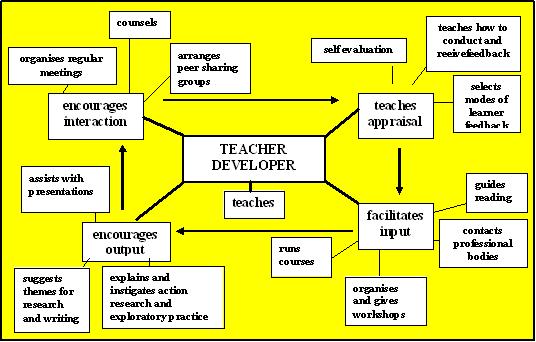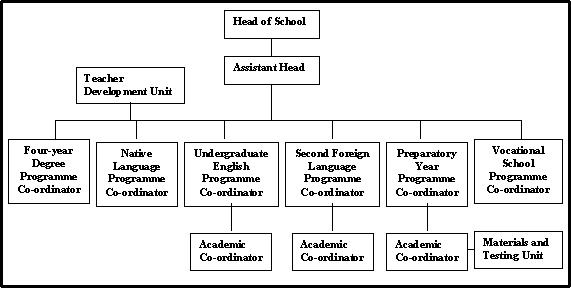Teacher Isolation
Steve Darn, Izmir University of Economics, School of Foreign Languages' Teacher Development Unit
[Editorial note: if you find Steve' article interesting you may want to look at What is Teacher Development?, Paul Davis, HLT Jan, 99 and at The Learning School, Adrian Underhill, HLT , Jan 2004]
 
'He's a real nowhere man
Sitting in his nowhere land
Making all his nowhere plans for nobody
Doesn't have a point of view
Knows not where he's going to
Isn't he a bit like you and me?'
(Lennon & McCartney)

Jeremy Hillary Boob PhD
 Jeremy, if you are old enough to remember, is the character in the Beatles' animated cartoon film 'Yellow Submarine', who sat at the bottom of the Sea of Holes, typing furiously, complaining that there was so much to do, yet desperately unhappy that he had no-one to share his work with, that is, of course, until the Yellow Submarine came along.
Jeremy, if you are old enough to remember, is the character in the Beatles' animated cartoon film 'Yellow Submarine', who sat at the bottom of the Sea of Holes, typing furiously, complaining that there was so much to do, yet desperately unhappy that he had no-one to share his work with, that is, of course, until the Yellow Submarine came along.

The Yellow Submarine
 Not so long ago, I was presenting a workshop at the British Council Teachers' Centre in Izmir, and as the Director of the Centre, was pleased that I had an audience of forty or so. Izmir is a city of around three and a half million in a country where all schools teach English as part of the national curriculum. A helpful colleague with the necessary contacts revealed that there were 2234 full-time teachers of English teachers in the city, excluding university instructors. So where were the other two thousand one hundred and ninety-four who weren't at my workshop (not to mention the university instructors)? Moreover, it occurred to me that my audience consisted almost entirely of familiar faces. Perhaps the others were too busy, perhaps they had not been informed, perhaps they were engaged in other forms of self-development, or perhaps they were just not interested. I was certainly not pro-actively enlarging the TEFL community. A number of messages came to mind:
Not so long ago, I was presenting a workshop at the British Council Teachers' Centre in Izmir, and as the Director of the Centre, was pleased that I had an audience of forty or so. Izmir is a city of around three and a half million in a country where all schools teach English as part of the national curriculum. A helpful colleague with the necessary contacts revealed that there were 2234 full-time teachers of English teachers in the city, excluding university instructors. So where were the other two thousand one hundred and ninety-four who weren't at my workshop (not to mention the university instructors)? Moreover, it occurred to me that my audience consisted almost entirely of familiar faces. Perhaps the others were too busy, perhaps they had not been informed, perhaps they were engaged in other forms of self-development, or perhaps they were just not interested. I was certainly not pro-actively enlarging the TEFL community. A number of messages came to mind:
- Those of us who consider ourselves 'aware' often preach to the converted.
- We do not always practise what we preach.
- A sense of community can only occur in certain cultivated circumstances.
- We have too much to do and often too many hats to wear.
- We need to meet face to face, improve the quality of our interaction, and cope with change collectively.
 Many teachers and trainers complain that they find it difficult to maintain momentum, that they are unable to come up with new ideas, or that the pace of methodological change is too much for them. The recently coined generic term 'burnout' seems to cover most of these maladies. However, it is also possible to argue that it is not the job of all teachers to be innovative, that since the arrival of the communicative approach, humanism and eclecticism, the rate of change in the profession has plateaued, and that all that is needed is interaction and stimulation. Perhaps the problem is that avenues for such interaction are unavailable, not made available, or unexploited.
Many teachers and trainers complain that they find it difficult to maintain momentum, that they are unable to come up with new ideas, or that the pace of methodological change is too much for them. The recently coined generic term 'burnout' seems to cover most of these maladies. However, it is also possible to argue that it is not the job of all teachers to be innovative, that since the arrival of the communicative approach, humanism and eclecticism, the rate of change in the profession has plateaued, and that all that is needed is interaction and stimulation. Perhaps the problem is that avenues for such interaction are unavailable, not made available, or unexploited.
 At the end of the 19th century, in the wake of industrialisation, Emile Durkheim was already warning the developed world of the dangers of a depersonalised society. Durkheim's concept of 'anomie' described a feeling of loneliness produced by a lack of quality interaction resulting from the expansion of society, particularly the urbanisation process and the emphasis on increased production and consumption rather than quality of life. Anomie is a state of normlessness, typical of in times of rapid social change, when existing rules, habits, and beliefs no longer hold and alternatives have yet to arise. Psychologically, anomie is manifest in depersonalisation - the retreat of the individual into an emotionless world in the face of an unknown future, rapid change, and perceived or real danger. Depersonalisation is in the very nature of modern society, and it is unfortunate and paradoxical that despite technological advance, teaching remains best done on a highly personal basis. There is immediate conflict at psychological, institutional, and, in the private sector, management levels. Educational managers seem to view education as a quaternary industry, and despite the general theoretical agreement that education and business meet best at the point of quality, are bent on delivering their product as quickly and as prolifically as possible, and on profit maximisation rather than optimisation. Key psychological, sociological, educational and economic concepts are abandoned readily in the name of progress. Depersonalisation occurs in professions which do not permit the venting of emotions. So do divorce, alcoholism and suicide.
At the end of the 19th century, in the wake of industrialisation, Emile Durkheim was already warning the developed world of the dangers of a depersonalised society. Durkheim's concept of 'anomie' described a feeling of loneliness produced by a lack of quality interaction resulting from the expansion of society, particularly the urbanisation process and the emphasis on increased production and consumption rather than quality of life. Anomie is a state of normlessness, typical of in times of rapid social change, when existing rules, habits, and beliefs no longer hold and alternatives have yet to arise. Psychologically, anomie is manifest in depersonalisation - the retreat of the individual into an emotionless world in the face of an unknown future, rapid change, and perceived or real danger. Depersonalisation is in the very nature of modern society, and it is unfortunate and paradoxical that despite technological advance, teaching remains best done on a highly personal basis. There is immediate conflict at psychological, institutional, and, in the private sector, management levels. Educational managers seem to view education as a quaternary industry, and despite the general theoretical agreement that education and business meet best at the point of quality, are bent on delivering their product as quickly and as prolifically as possible, and on profit maximisation rather than optimisation. Key psychological, sociological, educational and economic concepts are abandoned readily in the name of progress. Depersonalisation occurs in professions which do not permit the venting of emotions. So do divorce, alcoholism and suicide.
 For the psychological effects on the teacher, we might look at the work of a disciple of Durkheim's, Robert Merton. Merton argues that society promotes goals that we are expected to achieve, or try to achieve, whilst opportunities for such achievement may be insufficient. Thus a gap is created which produces enormous strain on individuals or groups and which may ultimately result in negative forms of behaviour from extremes such as total conformity and rebellion to introspection and retreatism. We see these behaviour patterns all too often in our institutions.
For the psychological effects on the teacher, we might look at the work of a disciple of Durkheim's, Robert Merton. Merton argues that society promotes goals that we are expected to achieve, or try to achieve, whilst opportunities for such achievement may be insufficient. Thus a gap is created which produces enormous strain on individuals or groups and which may ultimately result in negative forms of behaviour from extremes such as total conformity and rebellion to introspection and retreatism. We see these behaviour patterns all too often in our institutions.
 Fundamental to anomie, strain and depersonalisation, is the concept of social distance. In education, social distance is maximised when wide gaps occur between authorities, managers, middle-management and teachers. In the 21st century, with national and international bodies shaping the future of education, our decision-makers are often invisible, heads of institutions inaccessible, departmental heads and other middle-managers preoccupied with daily administration, and teachers left to fend for themselves, there is a distinct lack of consultation and an unhealthy reversion to top-down management. Change is imposed from above - national curricula, examination systems, technology, approaches favoured by publishers rather than authors, as well as demographic and socio-economic changes. Notwithstanding the rate and magnitude of such change, we are poorly equipped both psychologically and in terms of resources to cope with disruptions in our lives even at a personal level. We were told twenty years ago that such changes would occur, but we were either resistant or incapable of managing them. Now we have to manage their repercussions.
Fundamental to anomie, strain and depersonalisation, is the concept of social distance. In education, social distance is maximised when wide gaps occur between authorities, managers, middle-management and teachers. In the 21st century, with national and international bodies shaping the future of education, our decision-makers are often invisible, heads of institutions inaccessible, departmental heads and other middle-managers preoccupied with daily administration, and teachers left to fend for themselves, there is a distinct lack of consultation and an unhealthy reversion to top-down management. Change is imposed from above - national curricula, examination systems, technology, approaches favoured by publishers rather than authors, as well as demographic and socio-economic changes. Notwithstanding the rate and magnitude of such change, we are poorly equipped both psychologically and in terms of resources to cope with disruptions in our lives even at a personal level. We were told twenty years ago that such changes would occur, but we were either resistant or incapable of managing them. Now we have to manage their repercussions.
 So is the teaching community not a community as such? What has to happen to produce a professional community? Initial training courses such as CELTA produce a sense of community, albeit sometimes based on survival and a single common goal, but what happens after this initial bonding? Dispersal, readjustment, insecurity and institutionalisation. Making a difference is replaced by making a complaint, though those complaints may be justified as products of constraints imposed by the institution.
So is the teaching community not a community as such? What has to happen to produce a professional community? Initial training courses such as CELTA produce a sense of community, albeit sometimes based on survival and a single common goal, but what happens after this initial bonding? Dispersal, readjustment, insecurity and institutionalisation. Making a difference is replaced by making a complaint, though those complaints may be justified as products of constraints imposed by the institution.
 How, then, do we maintain a sense of belonging, and how do we avoid the psychological effects of 'ELT-anomie' or the professional condition of burnout? One suggestion is through collaboration, either organised or purely informal, on the assumption that burnout is a product of taking on too much and a response to chronic everyday stress, while research shows that burnout is drastically reduced when successful peer support exists. A recent article by Lindsay Clandfield on the 'onestopenglish' website proposes a seven-point scale of collaboration, starting at the micro-scale with sharing ideas, and progressing through discussion groups, peer observations, mentor programmes, inter-class communication and swaps to collaboration with other local institutions and world-wide collaboration via professional organisations and the Internet . There are, however, obstacles to the success of this scheme. At the micro-level, we have agreed that, like Jeremy, we have too much to do and too little time to do it. This raises two important questions: when do we indulge in this sharing process?, and whose responsibility is it to instigate it? At the macro-level, only those privileged enough to be members of the international TEFL community may benefit from most aspects of global collaboration, while the Internet is far removed from the face-to-face interaction which provides the personal support we require, and may well be seen as a mechanism which, whilst adding a new dimension to communication, only serves to extend the depersonalised society. Technology, for many, obviates the necessity to move, to verbalise, to express emotion and to engage in 'market-place' interaction.
How, then, do we maintain a sense of belonging, and how do we avoid the psychological effects of 'ELT-anomie' or the professional condition of burnout? One suggestion is through collaboration, either organised or purely informal, on the assumption that burnout is a product of taking on too much and a response to chronic everyday stress, while research shows that burnout is drastically reduced when successful peer support exists. A recent article by Lindsay Clandfield on the 'onestopenglish' website proposes a seven-point scale of collaboration, starting at the micro-scale with sharing ideas, and progressing through discussion groups, peer observations, mentor programmes, inter-class communication and swaps to collaboration with other local institutions and world-wide collaboration via professional organisations and the Internet . There are, however, obstacles to the success of this scheme. At the micro-level, we have agreed that, like Jeremy, we have too much to do and too little time to do it. This raises two important questions: when do we indulge in this sharing process?, and whose responsibility is it to instigate it? At the macro-level, only those privileged enough to be members of the international TEFL community may benefit from most aspects of global collaboration, while the Internet is far removed from the face-to-face interaction which provides the personal support we require, and may well be seen as a mechanism which, whilst adding a new dimension to communication, only serves to extend the depersonalised society. Technology, for many, obviates the necessity to move, to verbalise, to express emotion and to engage in 'market-place' interaction.
 It is at the middle, institutional level of collaboration that we might meet with most success. However, given that administrators and middle-managers are concerned primarily with operating systems, ensuring smooth running and preserving the status quo, someone has to take responsibility for organising intra-departmental collaboration. It is a sad reflection on the state of education that given time constraints and demands imposed from above together with the eternal responsibility to the learner, such collaboration is unlikely to happen naturally. The schema below clearly shows the central role of teacher development and the teacher-developer (not the teacher-trainer, as it was he/she who provided the initial sense of community) in this process. In this model, teachers interact, appraise, take on input and produce output, while teacher-developers encourage, facilitate and teach these processes. In the modern institution, the teacher-developer performs a push-pull function, leading, guiding and coaxing under circumstances which are not conducive to self-motivation. In this sense, teacher development logically adheres less to the much acclaimed reflective model than to the more traditional artisan-orientated, craft-based approach. There are other aspects of this schema which fall outside the bounds of contemporary idealism: solitary reflection is not recommended, peer observations are arranged, participation in teacher-development programmes is more than encouraged, and meetings are vitually mandatory. Apart from the need to rekindle intrinsic motivation by extrinsic means, the naked truth is that the self-motivated, reflective teacher is a product of educational theorists born and bred in an earlier era of diverse ideologies, rather than a reality. The products of liberalism are struggling with the constraints of neo-conservativism and post-modernist management. We have to find a middle way.
It is at the middle, institutional level of collaboration that we might meet with most success. However, given that administrators and middle-managers are concerned primarily with operating systems, ensuring smooth running and preserving the status quo, someone has to take responsibility for organising intra-departmental collaboration. It is a sad reflection on the state of education that given time constraints and demands imposed from above together with the eternal responsibility to the learner, such collaboration is unlikely to happen naturally. The schema below clearly shows the central role of teacher development and the teacher-developer (not the teacher-trainer, as it was he/she who provided the initial sense of community) in this process. In this model, teachers interact, appraise, take on input and produce output, while teacher-developers encourage, facilitate and teach these processes. In the modern institution, the teacher-developer performs a push-pull function, leading, guiding and coaxing under circumstances which are not conducive to self-motivation. In this sense, teacher development logically adheres less to the much acclaimed reflective model than to the more traditional artisan-orientated, craft-based approach. There are other aspects of this schema which fall outside the bounds of contemporary idealism: solitary reflection is not recommended, peer observations are arranged, participation in teacher-development programmes is more than encouraged, and meetings are vitually mandatory. Apart from the need to rekindle intrinsic motivation by extrinsic means, the naked truth is that the self-motivated, reflective teacher is a product of educational theorists born and bred in an earlier era of diverse ideologies, rather than a reality. The products of liberalism are struggling with the constraints of neo-conservativism and post-modernist management. We have to find a middle way.

The role of the teacher developer - a schema
 Reaction towards and against the proposed role of the teacher developer may come not only from liberal theorists and rebellious teachers. Teacher-developers do not fit neatly into the strata or hierarchy of institutional management (layered consultative management is now a meaningless concept since all managers are overtly seen to have their own agendas). Here is an example from a private English-medium university overseas with a rapidly expanding school of foreign languages:
Reaction towards and against the proposed role of the teacher developer may come not only from liberal theorists and rebellious teachers. Teacher-developers do not fit neatly into the strata or hierarchy of institutional management (layered consultative management is now a meaningless concept since all managers are overtly seen to have their own agendas). Here is an example from a private English-medium university overseas with a rapidly expanding school of foreign languages:

However, this does not mean that teacher-developers are a floating group of vigilantes. On the contrary, almost by definition and certainly out of necessity, they are detached from management and exert an alternative and oblique influence on teachers. They need also to be seen to be 'doing' and leading by example, but this is nothing new, since it has always been accepted that 'trainers' also teach and learn. They should not, however, be seen as occupying the position of a 'buffer state' between management and teachers. Whilst not directly representing authority, teacher-developers operating within an instititutonal framework need to exert a certain amount of pressure, since leaving it to the individual to reflect and take the initiative presents obstacles through the very nature of the individual:
- Individuals feel ill at ease and self-conscious.
- Individuals think about what they have to give up.
- Individuals feel alone even if everyone else is going through the same changes.
- Individuals can only handle so much change.
- Individuals are at different levels of readiness.
- Individuals are concerned about lack of resources - time, money, and skills.
- Individuals revert to previous behaviour patterns when the pressure is taken off.
 Individualism and solitude are both the cause and product of the depersonalised society, and a little more than gentle nudging is required to bring people together in a work environment which is less than conducive to collaboration. The community, as opposed to the individual, exhibits confidence, can cope with change, has collective resources, and is willing to move forward. Without a sense of community, we are all 'nowhere men' with frighteningly uncertain futures, but as team members, with guidance and encouragement, we can at least hope to make a difference, as did Jeremy when he boarded the Yellow Submarine.
Individualism and solitude are both the cause and product of the depersonalised society, and a little more than gentle nudging is required to bring people together in a work environment which is less than conducive to collaboration. The community, as opposed to the individual, exhibits confidence, can cope with change, has collective resources, and is willing to move forward. Without a sense of community, we are all 'nowhere men' with frighteningly uncertain futures, but as team members, with guidance and encouragement, we can at least hope to make a difference, as did Jeremy when he boarded the Yellow Submarine.

'Society has no raison d'etre if it does not bring men a little peace; peace in their hearts and peace in their mutual relations. If industry can only be productive by disturbing that peace, then it is not worth the cost.' (J.K.Galbraith, 'The Affluent Society' 1958).
Steve Darn
With thanks to Ian White for help and encouragement.
Steve Darn works as a teacher, teacher trainer and trainer- trainer in the Teacher Development Unit at Izmir University of Economics, Turkey. steve.darn@ieu.edu.tr


|